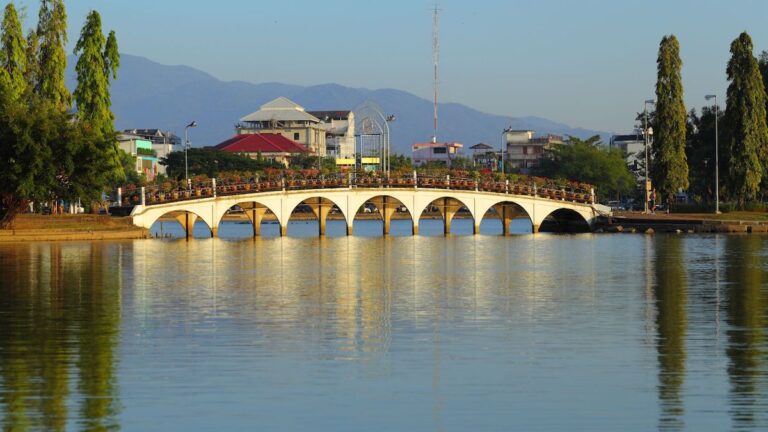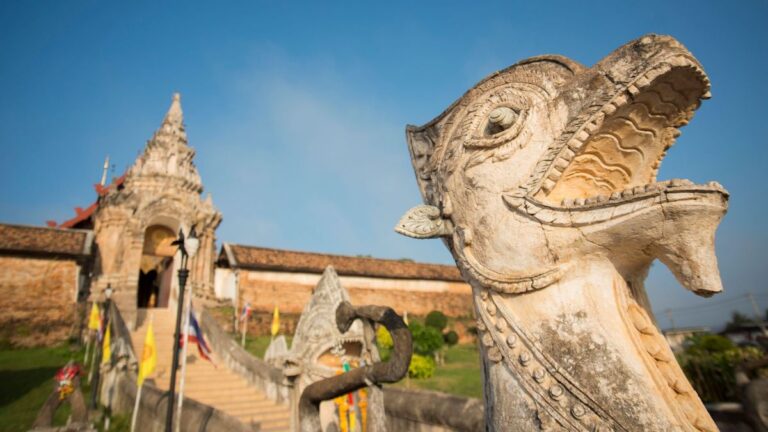Vimanmek Mansion
Amidst the array of stunning palaces and temples in Bangkok, Vimanmek Mansion stands out as a truly unique gem. This grand mansion, crafted entirely from teakwood, boasts Southeast Asian splendor like no other, making it one of the most beautiful mansions in Bangkok. Vimanmek Mansion offers a refreshing difference from the usual ornate Thai temples.
Admission: Unfortunately, Vimanmek Mansion is no longer open to visitors as it has been reclaimed by the Crown Property Bureau to be managed as a royal residence.
Construction: started in 1897
Architectural style: Victorian-Thai teakwood

History of the Vimanmek Mansion
As with much of Bangkok’s architectural heritage, Vimanmek Mansion is replete with a fascinating history and offers a fascinating insight into the background of the Thai royal family. The grounds in which the palace stands today, once composed of paddy fields and orchards and nestled between the Padung Krungkasem Canal and the Samsen Canal, were bought by King Rama V upon his return from traveling in Europe in 1897. His Majesty decreed that the land would be turned into a royal garden named Dusit Garden.
The king subsequently decided that the grounds would be home to a permanent residence for himself and the royal family, and he set about dismantling and transporting the fabulous teak palace from the island of Ko Sichang in Chonburi province. Following the successful rebuilding of the palace within the new gardens, the royal family took up residence in the palace for five years before moving back to the Grand Palace.
During the time of royal residence under King Rama V, the king had installed within the palace gardens and an enormous greenhouse complete with sprinklers powered by the four canals framing Dusit Gardens. The king’s intent was that the nursery would provide plants for the gardens and it is said that the king himself planted many of the trees and shrubs by hand to create lush, verdant surroundings for the palace to stand in.
The Thais are justifiably proud of Vimanmek Mansion, as arrival at the mansion proves. It is the biggest building in Dusit Gardens and its ornate style reflects Western influence. Vimanmek Mansion was designed by the brother of the then king, Prince Narisaranuwatiwong, who designed the palace in the shape of the letter L. The palace has two wings, one pointing north and one west, which meet each other at a 90-degree angle. Each of the wings is 60 meters in length and 25 meters tall.
The peak of the palace is the octagonal residence that made up the king’s rooms and is a stunning example of teakwood architecture, featuring not one single metal nail in its construction. Among the other 31 display rooms within the palace are bedrooms, bathrooms, and an audience chamber, all of which maintain their original decorations, while also within the palace are exhibition rooms housing fabulous collections of art, glassware, ceramics, silverware, and even ivory.
The story of Vimanmek Mansion continued through the 20th century when in 1925 King Rama VI consented to his wife, Queen Indharasaksaji, to allow her to utilize part of Vimanmek Mansion as her royal residence. Upon the death of King Rama VI, the queen moved out of Vimanmek and the palace has not been used as a royal residence since. Since 1930 the palace has been used as a storage house for royal artifacts and antiques, making it possibly the most extravagant and opulent storage facility in the world.
The Architecture of the Vimanmek Mansion
The architecture of the Vimanmek Mansion is a captivating blend of European and Thai-Contemporary styles, showcasing a remarkable fusion of cultural influences. During the reign of King Rama V, gingerbread houses from Europe gained popularity, and this ornate architectural trend inspired the design of the Vimanmek Mansion.
Constructed entirely from teakwood, the mansion stands as the world’s largest teakwood edifice, boasting an impressive showcase of intricate fretwork on windows and air passages.
The elaborate fretwork serves as a key element in creating detailed embellishments, giving the mansion a unique and enchanting appearance. This exquisite craftsmanship not only showcases the skill of Thai artisans but also reflects the King’s vision of blending traditional Thai elements with European elegance, making the Vimanmek Mansion a true masterpiece of architectural artistry.
Formerly a royal palace used by King Rama V of Thailand, the king had the palace dismantled and transported to Bangkok from its original home in Chonburi province. In 1982 the palace was renovated by King Rama IX at the request of his wife, Queen Sirikit, to turn it into the museum of King Rama V and showcase for Thai royal history that it is today. The palace gives visitors a chance to enjoy peace and tranquillity amid the normal hustle and bustle of Bangkok.
Later came the introduction of technology to the building, with King Rama VII decreeing that the palace be fitted with electrical wiring throughout. This installation formed part of an ongoing renovation process under King Rama VII, including repairs to the main pier on the Dusit Gardens’ lake.






